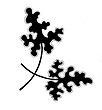ROCKS WITH STORIES
Ever since we began travelling through the western desert, we would tend to pick up rocks that looked intriguing to our untrained eyes. It wasn’t a jot more scientific than beach-combing or walking along a riverbed, picking up stones whose shapes or colours caught our eye.



These ones, we learnt, were from Jurassic formations of iron-rich sandstone, and you can see why they might have snagged our attention.
Slowly, we accumulated enough rocks with lovely earth colours – red and brown ochres, umbers, russet, cadmium yellow – to be able to make an artfully untidy pile under the sign announcing the ‘Colours of the Desert’, which was what we had named our collection of microhabitats.

_JPG.jpg)

It took us until the middle of 2015 to pluck up courage to start a more ‘serious’ rock collection.
In January of that year, we invited Professor Ashok Sahni from Lucknow and Pranay Lal from Delhi, to visit us in Jodhpur.
Prof. Sahni is, quite simply, India’s leading palaeontologist, and Pranay Lal leans far out of his professional day-job to explore and write engagingly about fossils, rocks and 'deep time'.
The plan was, after a few informative walks inside Rao Jodha Park, to set off together on a 3 day tour of the most interesting fossil sites in western Rajasthan.
_JPG.jpg)
I returned with a shiny new (but still small) vocabulary of geological terms and an exciting lens with which to explore the desert on future trips.
Over the next few months and years, we slowly put together a less amateurish collection, often on the trail of a specific type of rock with which to build up a story about the deep history of the Thar.
.jpg)
How could we tell our visitors that a particularly shiny or knobbly rock they had carried back from the desert was too 'weathered' to be of any interest?

.jpg)
.jpg)

_JPG.jpg)
_JPG.jpg)
.jpg)
A professor of geology at a University in Jodhpur chided us for bringing back specimens that he said were disappointingly ‘weathered’.
We tried to explain that ‘weathered rocks’ are precisely what you see when you’re an amateur exploring the desert – and that we were much more interested in interpreting what one encounters than digging out ‘pure’ minerals.
He was unimpressed, but that is how we began to put together our exhibit of rocks and minerals in Singhoria Pol.
In the rainy season of 2018, Pranay Lal came out to us again bringing with him another distinguished paleontologist, Prof. Rajeev Patnaik from Punjab University, and together they helped us identify the rocks that still had us puzzled.
With less than 3 hours to go for their return, Prof. Patnaik surprised me by suggesting we go visit the sandstone mines at Soorsagar to look for ‘Ediacaran fossils’.
What was the chance of finding anything worth bringing back in the 2 hours or so before they had to catch their plane?


Ediacaran
Ediacaran is a name given to a period in the earth’s history when the first multicellular forms of life came into being. It preceded the Cambrian Period when all the early shelled creatures like trilobites first appear in the fossil record. Unlike the hard shells and bones of fossils, Ediacaran rock formations preserve only the trackways and burrows of soft-bodied creatures.
These first signs of complex life-forms are appropriately called trace fossils to distinguish them from the actual remains of body-parts.
.jpg)
.jpg)
There are just a few places in the world where sandstone formations of Ediacaran age preserve trace fossils. One of them is a seam called the ‘Sonia formation’ inside Soorsagar’s mines.
Pranay seemed to know – heaven knows how – exactly where to go and within half an hour we were calling out to each other like excited little boys on a beach as we found treasures of raised discs and strange wiggly markings. These were all traces of early life from around 600 million years ago – life-forms that, to the best of anyone’s knowledge, had left no descendants.
.jpg)
No one is quite sure precisely what kind of life-forms these Ediacaran creatures were.
.jpg)
.jpg)

Shoutout to Indonesian artist FRANZ ANTHONY who created these artworks.
.jpg)
Some finds suggest they were a bit like seaweed.
Other traces look like they were made by worms – and strange floaty forms that scientific artists have tried to depict as jellyfish-like creatures anchored to the floors of shallow seas. This (RIGHT & BELOW) is how one artist has depicted what they might have looked like.

One large upright slab of Ediacaran sandstone with seaweed-like trace fossils now forms the centrepiece of our collection of rocks in the Visitors Centre.
But even as I write this, I know that this collection will continue to grow and morph as we find newer and better specimens in the desert in years to come.
February of 2013
Time to open the Park